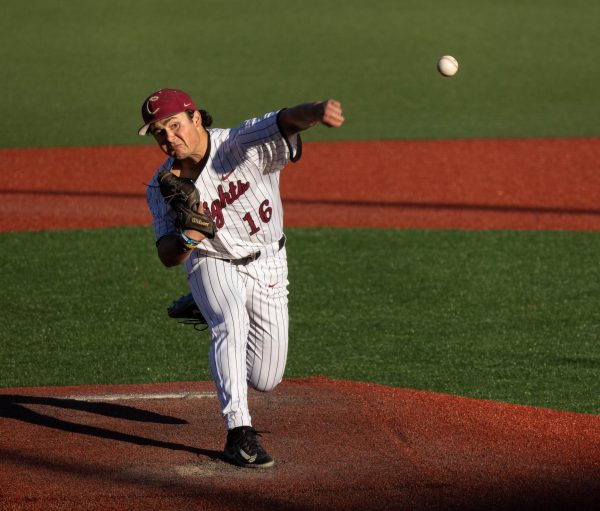OSU’s persistent mice problem sneaks by students for decades
Rodent trap outside West Hall on Oct. 20, in Corvallis, Ore. These traps are used to prevent mice and other rodents from entering the building by capturing them in a live trap.
November 11, 2021
Oregon State University is treating mice on campus using similar measures they have used in the past, but some students are only now becoming aware of the issue.
Steve Clark, vice president of University Relations and Marketing, said there have been mice on campus for a long time.
“Simply put, mice and other rodents have been in human society forever and cannot be fully eliminated, but their presence and impact can be prudently and intentionally minimized, such as what we are doing on campus,” Clark said.
According to the U.S. Environmental Protection Agency, the term rodents actually refers to many species, including squirrels, chipmunks, beavers and prairie dogs, as well as rats and mice.
During fall months, Clark said rodents may become more active as cold weather encourages them to look for dryer and warmer places to live.
“The presence of rodents on OSU’s Corvallis campus this year is about the average or less to date than is typical,” Clark said.
OSU facilities crews are addressing the problem, just as they have in previous years.
“OSU facilities crews have placed significant attention over the last decade to using measures to exclude rodents from campus buildings,” Clark said.
According to Clark, rodent exclusion measures are implemented to keep OSU community members safe and well, but also to protect research that is done on campus and ensure high standards of sanitization in food service areas.
Helena Duke, a first-year horticulture student at OSU, said previous knowledge about the rodent issue would not have affected her decision to attend class at OSU.
“I had no idea there were mice on campus,” Duke said. “[But], because of my experience with animals, I am unfazed by mice.”
However, Duke admitted that the mice could be a concerning factor for other students who had decided to attend OSU.
“I feel as though OSU should be more open about issues which affect students on campus,” Duke said. “On the topic of the pest issue, they should be more open.”
Pests such as mice and other rodents can carry diseases like salmonella, hantavirus and more.
Clark said rodents are typically found around buildings people gather in or where food is commonly prepared.
“This includes university and college campuses, including OSU,” Clark said. “Rodents typically are found around and sometimes in buildings where there are food sources within and those buildings that provide even limited or very small points of access to dry and warm locations where a rodent may seek to live.”
OSU has four priority steps they follow when addressing the presence of rodents on campus, according to Clark.
Step one is to identify where a rodent may enter. Step two is to mitigate the food sources that may attract mice.
“In this case, we encourage students and employees to not leave food items in their offices, work and study areas or residence hall rooms, but to store food within a floor kitchen,” Clark said.
Step three is to eliminate habitats that allow mice to thrive. For example, Clark said OSU eliminates vegetation such as ivy and St. John’s Wort, a flowering plant on campus.
Step four is to use traps, which are currently located in and around many OSU buildings. Step five is the use of bait stations or boxes, which are designed specifically to allow rodents to enter and eat treated bait. Bait treatment is typically a method used to entice rodents to ingest poison and die later on.
Gina Kesecker, office manager at Good Earth Pest Company in Corvallis, has professional knowledge about what it takes to properly get rid of mice.
Kesecker runs the day-to-day operations of all the staff members at Good Earth. Currently, Good Earth has 22 field technicians that go out and perform pest control services.
“Ten of them work in our rodent division,” Kesecker said.
Good Earth focuses on protecting and sealing structures where mice may get in and has seen a large increase in rodent work throughout the Willamette Valley.
Kesecker said this may be due to people being home more during the COVID-19 pandemic since it has allowed them to see and hear things they may not normally experience.
“We have been very successful at being able to get mice and rats out of homes and businesses,” Kesecker said.
Clark said a dozen buildings on campus are prioritized for rodent pest control measures.
“They include dining centers and research buildings,” Clark said. “The amount of traps vary at any one time depending on whether or not rodents are present.”
The traps on campus are serviced weekly and increase in frequency if an issue is reported.
“We believe the university is engaging in prudent and effective responses to the presence of rodents,” Clark said.

























































































































Lary E. Adkins • Feb 26, 2023 at 4:04 am
Check out the story in athletic business “exterminator-shines-light-on-stadium-rodents”
Your sources telling readers that it’s not possible to eliminate rodents completely are wrong, it is absolutely possible to completely eliminate rodents from stadiums. Very few exterminators know how to go about it because they haven’t studied their adversaries habits well enough to deal with them.